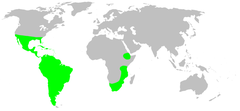Caponiidae
This article includes a list of generalreferences,butit lacks sufficient correspondinginline citations.(April 2019) |
| Caponiidae Temporal range:
| |
|---|---|

| |
| Left:Nops guanabacoae Middle and right:Cubanops alayonifemale and male | |
| Scientific classification | |
| Domain: | Eukaryota |
| Kingdom: | Animalia |
| Phylum: | Arthropoda |
| Subphylum: | Chelicerata |
| Class: | Arachnida |
| Order: | Araneae |
| Infraorder: | Araneomorphae |
| Family: | Caponiidae Simon,1890 |
| Diversity | |
| 19 genera,124 species | |

| |
Caponiidaeis a family ofecribellatehaplogynespiders that are unusual in a number of ways. They differ from other spiders in lackingbook lungsand having the posterior medianspinneretsanteriorly displaced to form a transverse row with the anterior lateral spinnerets. Most species have only two eyes, which is also unusual among spiders. A few species of Caponiidae variously have four, six or eight eyes. In some species the number of eyes will increase when the spiderling changes its skin as it grows towards adulthood.
Description
[edit]These spiders of about 2 to 5 millimetres (0.079 to 0.197 in) are rarely noticed, but generally look like somewhat fadedwoodlouse hunter spidersin the genusDysdera.Thecarapace(cephalothorax or prosoma) is orange and theabdomen(opisthosoma) light gray. The two-eyed species have their two eyes in the anterior middle of the carapace.
Eye numbers
[edit]Caponiidae are unusual in the degree to which the eye number varies. In this they surpass even the familyCybaeidaein which some species have two eyes, some six, and some eight. In some species of the Caponiidae paired eyes meet in the midline, giving the spider in effect, an odd number of eyes. The following genera have eyes as follows:
- Eight eyes:Calponia,Caponia(but latter may also have two, three, four or 'five' eyes)
- Six eyes:Iraponia
- Four eyes:Nopsides,Notnops
- Two eyes:Cubanops,Diploglena,Laoponia,Medionops,Nops,Nopsma,Nyetnops,Orthonops,Taintnops,Tarsonops,Tisentnops.
Habits
[edit]Their habits are for the most part unknown. At least some species are known to hunt other spiders.
Relationships
[edit]The fact that they areecribellateandhaplogynesuggests that they might be relativelyprimitive.Calponia harrisonfordifromCaliforniaseems to be the most primitive member of the family. Their phylogenetic relationships have long been enigmatic, but in the early 1990s it was determined that they are probably a sister group of theTetrablemmidaeplus the four families inside the superfamilyDysderoidea.
The subfamily Nopinae consists at least of the generaNops,Nopsides,OrthonopsandTarsonops.The remaining genera are unlikely to form amonophyleticgroup.
Distribution
[edit]The family is found inAfricaand theAmericasfromArgentinato the United States.
Names
[edit]Calponiais a contraction ofCalifornian Caponia,because the single speciesCalponia harrisonfordihas, like the African genusCaponiaeight eyes. The species name is in honor ofHarrison Ford,recognizing his efforts on behalf of theAmerican Museum of Natural History.
The Chilean caponiid fauna differs from that of the rest of the Neotropics in lacking members of theNopinae(named after the genusNops). Three genera newly described byNorman I. Platnickin 1994 were thus namedNotnops,TaintnopsandTisentnops,emphasizing this fact. The onlyTaintnopsspecies,T. goloboffi,is named in honor of one of the collectors, P.A. Goloboff.
Genera
[edit]As of April 2019[update],theWorld Spider Catalogaccepts the following genera:[1]
- AamunopsGalán-Sánchez & Álvarez-Padilla, 2022— Mexico
- CalponiaPlatnick, 1993— United States
- CaponiaSimon, 1887— Africa
- CaponinaSimon, 1892— South America, Caribbean, Central America
- CarajasBrescovit & Sánchez-Ruiz, 2016— Brazil
- CubanopsSánchez-Ruiz, Platnick & Dupérré, 2010— Cuba
- DiploglenaPurcell, 1904— South Africa, Namibia, Botswana
- IraponiaKranz-Baltensperger, Platnick & Dupérré, 2009
- LaoponiaPlatnick & Jäger, 2008— Laos, Vietnam
- MedionopsSánchez-Ruiz & Brescovit, 2017— South America, Panama, Trinidad
- NasutonopsBrescovit & Sánchez-Ruiz, 2016— Brazil
- NopsMacLeay, 1839— South America, Mexico, Central America, Caribbean
- NopsidesChamberlin, 1924— Mexico
- NopsmaSánchez-Ruiz, Brescovit, Bonaldo 2020— South America, Mexico, Central America
- NotnopsPlatnick, 1994— Chile
- NyetnopsPlatnick & Lise, 2007— Brazil, Ecuador
- OrthonopsChamberlin, 1924— United States, Mexico
- RoddenberryusSánchez-Ruiz & Bonaldo, 2023— Costa Rica, Mexico, Cuba, Guatemala
- TaintnopsPlatnick, 1994— Chile
- TarsonopsChamberlin, 1924— Cuba, Central America, Mexico
- TisentnopsPlatnick, 1994— Chile, Brazil
See also
[edit]References
[edit]- ^"Family: Caponiidae Simon, 1890".World Spider Catalog.Natural History Museum Bern.Retrieved2019-04-22.
- Kranz-Baltensperger, Y., N. Platnick & N. Dupérré (2009). A new genus of the spider family Caponiidae (Araneae, Haplogynae) from Iran.American Museum Novitates,3656:1-12.[1]
- Platnick, N.I. (1993) A New Genus of the Spider Family Caponiidae (Araneae, Haplogynae) from California.American Museum Novitates3063.PDF(Calponia)
- Platnick, N.I. (1994). A Revision of the Spider GenusCaponina(Araneae, Caponiidae).American Museum Novitates3100.
- Platnick, N.I. (1994). A Review of the Chilean Spiders of the Family Caponiidae (Araneae, Haplogynae).American Museum Novitates3113.PDF
- Platnick, N.I. (1995). A revision of the spider genusOrthonops(Araneae, Caponiidae).American Museum Novitates3150.PDF(five new species)
- Platnick, N.I. & P. Jager (2008). On the first Asian spiders of the family Caponiidae (Araneae, Haplogynae), with notes on the African genus Diploglena.American Museum Novitates,3634: 1–12.[2]
- Platnick, N.I. & A. Lise (2007). On Nyetnops, a new genus of the spider subfamily Nopinae (Araneae, Caponiidae) from Brazil.American Museum Novitates,3595:1-9.[3][permanent dead link]
- Sánchez-Ruiz, A., N.I. Platnick, and N. Dupérré (2010). A new genus of the spider family Caponiidae (Araneae, Haplogynae) from the West Indies.American Museum Novitates3705: 1–44.[4]
